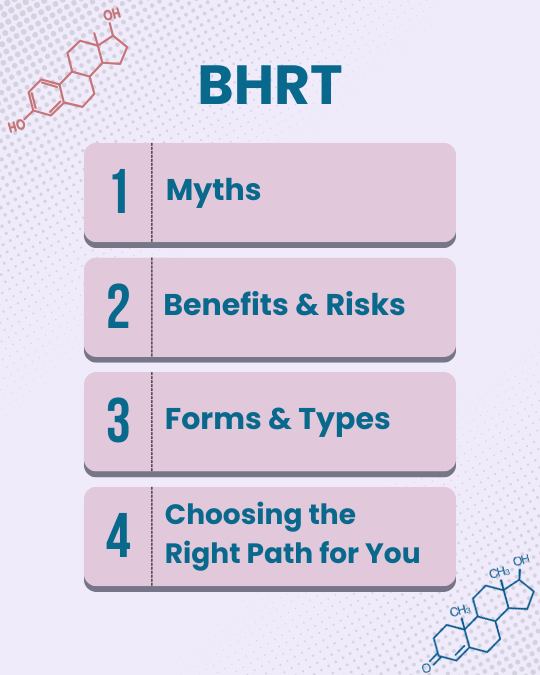Let’s Talk Bioidentical Hormone Replacement Therapy
Written by Dr. Natalie Barriball
Bioidentical Hormone Replacement Therapy (BHRT) is a common way to support the menopause transition and enhance overall health during aging. It includes using hormones molecularly identical to the ones made in the body to treat hormonal imbalances in aging, menopause, andropause, and other hormonal conditions.
Why Bioidentical? (1)
There are two types of hormone replacement: synthetic and bioidentical.
Synthetic hormones have a different molecular structure compared to the hormone molecules our bodies make, which allows them to be much more potent. Synthetic hormones are most commonly seen in birth control products, as the potentiated form allows shutting off of reproductive functions, resulting in contraception. Synthetic hormones are frequently used for hormone replacement in menopause, but are progressively falling out of favor due to higher associations with cancer and blood clot risk. There is also standardized dosing, making it better regulated by the FDA but more difficult to individualize.
Bioidentical hormones are increasing in popularity due to their lower risk and side effect profile. These hormones, as the word implies, are identical to the molecular structure of the body’s hormones. They bind hormone receptors in the same way and to the same effect. This makes them a true “replacement” for the hormones being lost during aging. They are considered safer because of this and are better tolerated by the body. Many forms of bioidentical hormones can be custom-compounded to fit an individual patient. The main criticisms are less regulation by the FDA and less established research.
Myths About BHRT
All hormone therapies cause cancer.
FALSE: The risk of cancer depends on type, route, dose, and balance between hormones. Bioidentical hormones are safer than synthetic, and transdermal (topical) estrogens have a lower risk of clot and stroke than oral. Using estrogen without progesterone risks uterine health, but using estriol or testosterone may be protective for breast health. These factors matter, and it is important to consider all variables and look into pros and cons of all therapies being considered. And as you continue reading, hopefully more questions will be answered.
BHRT is just for menopause.
FALSE: BHRT can be utilized in PCOS, painful periods, premature ovarian failure, perimenopause, surgical menopause, andropause, and other hormone deficiencies.
Only women need BHRT.
FASLE: Men can also benefit from testosterone replacement therapy to address low libido, fatigue, metabolic health, muscle loss, and mental health in aging.
Once you start BHRT you can never stop.
FALSE: BHRT can be used for variable amounts of time, and can be tapered or stopped when needed.
BHRT is 100% natural and risk-free.
FALSE: While BHRT uses hormones structurally identical to the body’s, it is essential to note that any natural thing out of balance can present a problem. BHRT should be used under the supervision of a doctor trained in prescribing it and capable of following it with lab values and general health evaluations. Dosing, timing, hormone type, and forms matter to keep this therapy safe!
Benefits and Risks/ Side Effects of BHRT (2)
*Many side effects either resolve over time with continued use or are from wrong dosing or form. Always talk to your prescriber if experiencing side effects.
Forms of BHRT (1)
Creams and Gels
Description: Topical applications that are best absorbed through the thin skin of the inner arms or thighs.
Pros: Bypasses the liver and digestive system, potentially causing fewer side effects. Allows for consistent hormone delivery. Creams can be compounded to meet an individual’s specific needs, and multiple hormones can be compounded into one formula.
Cons: Can be messy and requires careful application to avoid transferring to others through skin contact.
Patches
Description: Adhesive patches that release hormones through the skin over a set period.
Pros: Provide steady hormone levels and are easy to use, only needing to be changed every few days.
Cons: May cause skin irritation at the site of application, may require rotation of patch site to prevent.
Vaginal Suppositories/Creams
Description: Hormones applied directly to the vaginal area.
Pros: Effective for addressing vaginal dryness and other localized symptoms.
Cons: Can be messy and may require consistent application. Not for systemic use, but can have some mild systemic absorption.
Sublingual Drops or Troches
Description: Tablets or drops taken under the tongue for absorption.
Pros: Bypasses the digestive system for quicker absorption.
Cons: Taste may be unpleasant, and dosing can be less precise.
Pills
Description: Oral tablets that contain bioidentical hormones.
Pros: Easy to use and widely available.
Cons: May be harder on the liver as the hormones have to pass through the digestive system first. Amount utilized can depend on individual metabolisms.
Injections
Description: Hormones administered via intramuscular injection.
Pros: Direct delivery, providing quick and controlled dosing.
Cons: May be painful or inconvenient due to the need for frequent injections ranging from weekly to monthly.
Pellets
Description: Small pellets inserted under the skin that slowly release hormones over several months.
Pros: Long-lasting (3-6 months) and convenient, with a steady release of hormones.
Cons: Requires a minor surgical procedure for insertion and removal. Some patients may absorb hormones at varying rates, which can lead to symptoms of high or low hormone levels.
Bioidentical Hormones Available
The most popular hormone replacement talked about with menopause is estrogen, but this is just one piece of the puzzle. All sex hormones can decline with age, meaning multiple hormones may be needed to achieve the best outcomes.
Estradiol
The strongest form of estrogen, estradiol, supports bone, brain, and heart health and alleviates symptoms such as hot flashes, night sweats, and vaginal dryness.
Estradiol should ALWAYS be taken with progesterone as progesterone balances the estradiol and protects the uterus from a thickened lining and endometrial cancer.
Estriol
Estriol is a lesser-known estrogen, as it is much weaker compared to estradiol. But despite being weaker, it can still support systems and alleviate symptoms similarly to estradiol. It can be used alone or in combination with estradiol for potential protective effects against estrogen related cancers and adverse symptoms (3).
Progesterone
Progesterone helps brain function and sleep, two areas commonly affected in menopause. It also protects the uterus in estrogen use (4).
Testosterone
While typically known as a male hormone, females possess testosterone too, and it is critical for bone and muscle health/ strength, energy, libido, and cardiometabolic health. Some research shows it may be protective against breast cancer (5).
DHEA
A hormone not commonly known, DHEA is made primarily by the adrenal glands and converts to testosterone and estrogen in the body. It helps with energy, inflammation, mood, bone health, libido, and cognitive function (6).
Pregnenolone
Pregnenolone is a precursor hormone used as the main ingredient to make all other sex hormones, cortisol, and aldosterone. In addition to supporting overall hormone production, it is also known for neuroprotective qualities, enhancing cognitive function, improving mood and mental health, and modulating inflammation (7).
Choosing the Right Path for You
BHRT can be a great tool to support menopausal symptoms and overall health. Deciding whether to start should be based on shared decision-making between you and your doctor. Here are some questions to determine if BHRT is right for you and, if so, how to go about starting.
Questions to Ask:
Is BHRT right for me?
Based on lab levels, symptoms, current and past conditions, and personal medical preference, BHRT is a very individual decision. If you need support for menopausal symptoms, want to prevent conditions of aging, and want to improve overall health, it may be worth considering.
Here are some reasons why BHRT may not be right for you:
Past or present breast, uterine, or ovarian cancer.
Active or recent thromboembolic disease (DVT, PE).
History of stroke or heart attack.
Active liver or gallbladder disease.
Active seizure disorder, migraines, or uncontrolled hypertension.
You prefer alternative treatments to hormones or medications.
Expense is a concern, as BHRT is often an out-of-pocket cost not covered by insurance.
You have sensitivity to hormones or hormonal changes.
Which hormones should I use?
This is highly dependent on lab levels and symptom picture. Many patients notice the best benefits on a combination of hormones, but is important to evaluate the whole picture. And remember, estrogen should always be used with progesterone to protect uterine and breast tissue.
Which form should I use?
The type of form to use is based on individual factors, such as:
How many and which hormones are being used.
For example, creams may be more helpful for combinations.
Dosing required.
Injections and pellets are more potent than topical forms.
Patient age.
Higher dose forms may be better indicated for younger patients, and lower dose forms for older patients.
Forms with tighter control on dosing may be useful in starting out or as aging occurs and lower levels are needed.
Symptoms being addressed.
Vaginal dryness is best addressed with topical vaginal creams, whereas hot flashes benefit most from systemic forms.
Which is best absorbed.
This varies by individual. Sensitive patients may not do well with pellets or injections due to their high absorption rates, and some patients don’t absorb well through skin.
Convenience
Whether daily, every few days, every few weeks, or every few months is best is an entirely individual preference.
Budget
Costs vary across forms so cost-comparison may be helpful.
Compliance
Consistency of daily dosing can be hard for some to remember, whereas staying on top of office visits for pellets every few months is difficult for others. Consider individual preferences and abilities.
The choice to initiate BHRT, and the best type and form, depends on individual needs, lab levels, preferences, and goals. Remember that regular monitoring and adjustments are necessary to ensure optimal results and minimize negative effects. Discuss with your doctor to determine the best plan for you!
References:
https://my.clevelandclinic.org/health/treatments/15660-bioidentical-hormones
https://my.clevelandclinic.org/health/treatments/15245-hormone-therapy-for-menopause-symptoms
Donovitz G, Cotten M. Breast Cancer Incidence Reduction in Women Treated with Subcutaneous Testosterone: Testosterone Therapy and Breast Cancer Incidence Study. Eur J Breast Health. 2021 Mar 31;17(2):150-156. doi: 10.4274/ejbh.galenos.2021.6213. PMID: 33870115; PMCID: PMC8025725.
Murugan S, Jakka P, Namani S, Mujumdar V, Radhakrishnan G. The neurosteroid pregnenolone promotes degradation of key proteins in the innate immune signaling to suppress inflammation. J Biol Chem. 2019 Mar 22;294(12):4596-4607. doi: 10.1074/jbc.RA118.005543. Epub 2019 Jan 15. PMID: 30647133; PMCID: PMC6433066.



